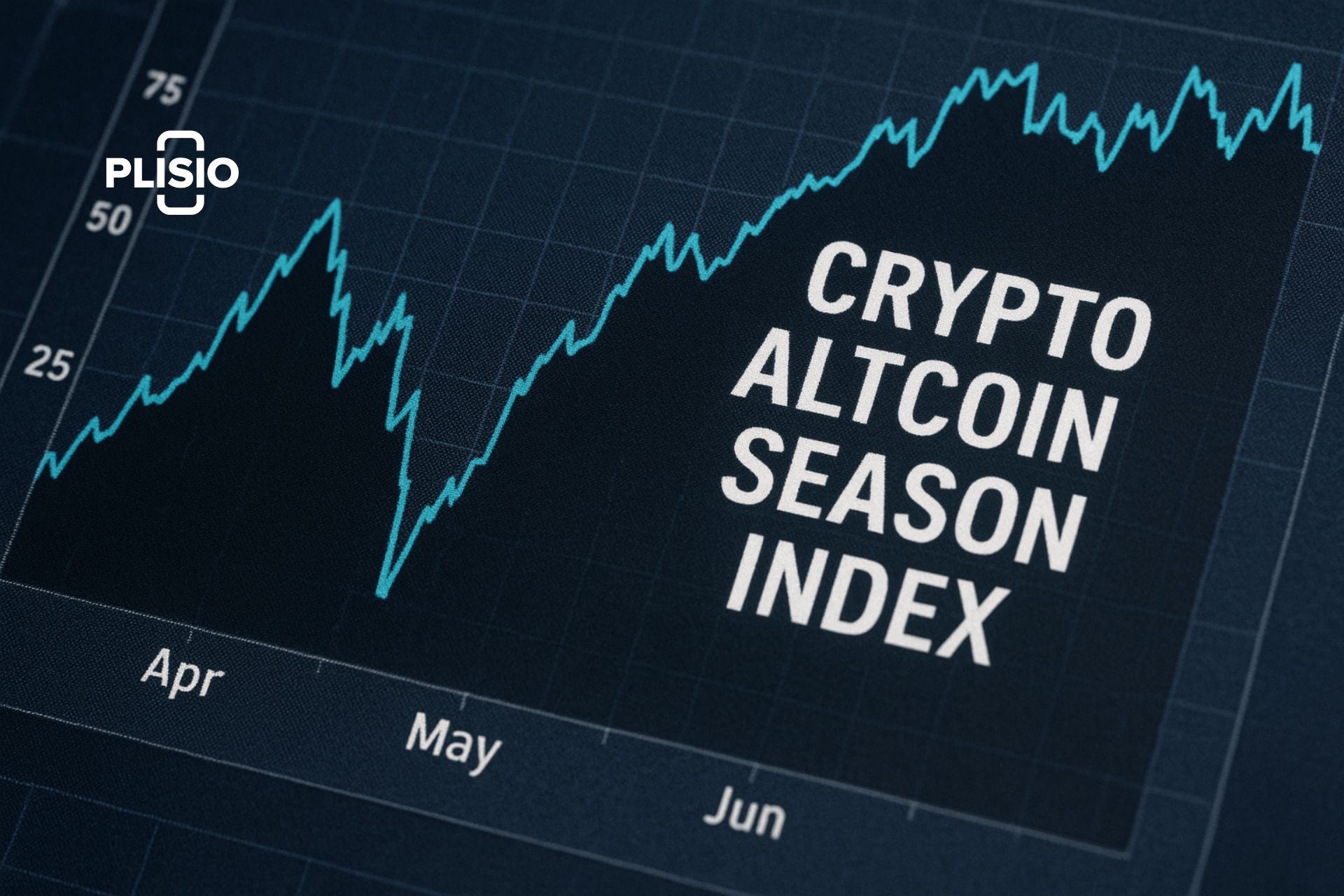Altcoin Season Index 2025: Predicting Crypto Market Booms

Are you excited about the upcoming cryptocurrency season and want to discover how experienced investors make money trading cryptocurrencies?
You are in the right place! We'll speak about how the altcoin season index and Bitcoin function together in this blog.We'll also speak about how altcoin seasons effect Bitcoin's success in the market and what it means for Bitcoin to become more popular.
Consider this: The last altcoin season, which ran from late 2020 to May 2021, saw the price of Ethereum rise from $600 to more over $4,100.At the same time, the values of Cardano and BNB, two other altcoins, went up by more than 1,300% and 2,000%, respectively. The altcoin index demonstrates that this was a terrific moment for investors because a number of cryptocurrencies went up a lot during this time.
Stay with us as we decode the complexities of the cryptocurrency world and help you understand the dynamics of these market forces better.
We'll look at historical data to explain past altcoin seasons and identify key indicators that signal when the next one might begin, especially as we approach 2025. Our insights aim to provide practical advice for traders looking to make informed decisions.
Altcoin Season Index Explained: A Key Indicator for Traders
The Altcoin Season Index shows how well alternative cryptocurrencies, or altcoins, are doing compared to Bitcoin (BTC) and gives information about the switch to altcoins. Altcoins are any cryptocurrency that isn't Bitcoin. If you're new to the subject, here is what they are.
This index shows how the market is changing, which is highly helpful for investors and traders since it lets them recognize the trends and make better decisions about whether to purchase or sell.
When the index is high, it suggests that altcoins will probably do better than Bitcoin.People often call this time of year "altcoin season." A lot of people look to altcoins during these periods because they think they may make money as these currencies become more valuable compared to Bitcoin. Knowing when these seasons occurs will help investors a lot in the ever-changing crypto market.
How the Altcoin Index Works: Calculating the 2025 Market Shift
The Altcoin Season Index is determined by looking at the performance of the top 50 altcoins compared to Bitcoin over a 90-day period. This timeframe helps filter out short-term fluctuations and gives a clearer picture of longer-term market trends, particularly regarding the altcoin season index measures.
To calculate this index, data from these altcoins are collected and their price changes are analyzed. If, for example, 75% of these top 50 altcoins perform better than Bitcoin during the period, the index signals the beginning of what is known as an "altcoin season."
To find a percentage, divide the number of altcoins that have done better than Bitcoin by the entire number of altcoins being watched. After that, double it by 100.
This is the number that makes up the index score, which can be any number between 0 and 100.A score of 100 means that altcoins are doing much better than Bitcoin and that this is a very good time for altcoins. On the other hand, a score close to 0 means that Bitcoin is doing far better than altcoins. This index can assist traders and investors make smarter choices by showing them when altcoins might be more profitable than Bitcoin.
Past Altcoin Seasons: Lessons from Previous Crypto Market Cycles
You may look into how altcoins have done throughout big changes in the market if you know how the market works.
You might be able to notice the patterns and trends that keep happening in the cryptocurrency market if you look back at past altcoin seasons.During these moments, the bitcoin ecosystem often achieves a lot of progress.
In 2017, the prices of Bitcoin and other cryptocurrencies went up a lot. This was fantastic for the market. This was because more people were adopting blockchain and initial coin offers (ICOs) were becoming increasingly common.Cryptocurrency seasons have also followed similar patterns in later market cycles, with prices rising swiftly and then falling sharply.
You need to know why these changes happen so that you can better forecast what will happen in the future and keep your investments safe.
Crypto Market Trends: Key Insights from Past Altcoin Season Index Data
Some altcoins did a lot better than others throughout the altcoin season index 2025. For instance, Ethereum's price shot up in 2017 because of its cutting-edge smart contract technology and application inrelated programs (DApps).
The first cryptocurrency season ran from 2017 to 2018, and the second ran from 2020 to 2021.Both have a big impact on the crypto market as a whole. Bitcoin's market share dropped a lot in the first season, but altcoins like EOS gained a lot. They raised $4 billion through an ICO presale, and at its peak, the company was worth $16 billion, up from $200 million.
Market Impact and Future Prospects for altcoins in 2025, especially as the index helps track their performance against Bitcoin.
The last altcoin season, which ran from 2020 to 2021, brought millions of new investors to the crypto exchange market. The pandemic, economic stimulus funds, and extra leisure time were all reasons for this. Altcoins like MATIC, SOL, AVAX, and DOT became increasingly popular, and non-fungible tokens (NFTs) became a new way to invest, especially when it came to money coming in from Bitcoin.At this point, the market cap for altcoins jumped from $200 billion to $1.6 trillion.
Even though there have been some challenges lately, a lot of people think that cryptocurrencies could grow a lot if the market keeps going the way it has been. The market cap of all cryptocurrencies, save for Bitcoin and Ethereum, has been robust. This means that there may be opportunity for more growth based on how the market has acted in the past.
Top Indicators of an Upcoming Alt Season Surge in 2025
Rising Altcoin Dominance: This term is crucial when analyzing the market dynamics, especially during periods when altcoins have outperformed Bitcoin.
An increase in altcoin dominance is a strong hint that an altcoin season may be coming. This word means the total value of all cryptocurrencies save Bitcoin, as a percentage of the total value of the market.
When altcoin dominance starts to rise, it means that investors are putting more money into altcoins, which shows that they are becoming more confident in these alternatives to Bitcoin.
Decreasing Bitcoin Dominance often correlates with the start of altcoin season, highlighting shifts in investor sentiment.
Also, when Bitcoin's percentage of the whole market goes down, it usually suggests that altcoins are about to do well. Bitcoin dominance shows how much of the market's entire value is in Field of Bitcoin. This affects the overall altcoin trading Merchants and the chances potential for various altcoins to succeed.When this figure goes down, it usually means that money is going into altcoins. This could mean that altcoin season is about to start because Bitcoin dominance is going down. When Bitcoin dominance dips substantially, altcoins often start to rise, according to past patterns.
Increased Trading Volume
You should also pay attention to how many more people are buying and selling cryptocurrencies. As more people trade these coins, there may be more interest in and investment in them. This might make it easier to sell them and cause their prices to go up and down more.This increase is a strong evidence that more people are interested in digital currencies.
You might be able to see changes in the market before they happen if you pay attention to the trading volumes of coins like Tether (USDT), which are utilized in a lot of agreements.This is especially true when Bitcoin or another cryptocurrency is rising, since the whole crypto market usually reacts to these changes. Tether is used by a lot of people when the prices of cryptocurrencies are set to change a lot. After that, things get busier with major coins like Bitcoin and Ethereum.
If investors use these signals together, they could be able to tell when altcoins would do better than Bitcoin, which would provide them chances to make money.
How to Spot When Altcoin Season Starts Using the Index
Key Indicators and Useful Signals: These indicators can include the altcoin season index, which helps track the focus from Bitcoin to altcoins.
If you're interested in cryptocurrency investment, especially in altcoins, knowing when the next altcoin season might start is crucial. Here are some indicators that can help you spot the onset of an altcoin season and shifts in btc dominance.
Bitcoin Dominance Chart (BTCD)
The Bitcoin Dominance Chart is a critical tool. It shows Bitcoin's share of the total cryptocurrency market capitalization. A falling trend in this chart often points to increasing interest in altcoins. This shift could signal the beginning of an altcoin season, where altcoins may start to increase in value as more investors turn their attention away from Bitcoin.
Altcoin Market Capitalization (excluding Bitcoin and Ethereum)
Another important metric to watch is the market capitalization of altcoins, excluding Bitcoin and Ethereum, often represented as TOTAL3 in charts available on platforms like TradingView. Monitoring the trends and cycles in this chart can provide insights into how altcoins are performing independently of the major players.
By studying the historical data and patterns in the TOTAL3 chart, you can see how altcoins tend to move in cycles similar to those in the past. These insights can help predict when we’re in an altcoin season, offering potentially lucrative opportunities for investors.
Together, these indicators can give a clearer picture of when the market is shifting in favor of altcoins, helping you make informed decisions about when to invest based on the bitcoin dominance index.
Bitcoin Dominance vs. Altcoins: Market Cap Dynamics and Technical Analysis
Bitcoin Price Fluctuations
Bitcoin’s role in the cryptocurrency market is critical. Its market dominance is a key indicator of the overall market health. When Bitcoin’s dominance rises after a period of consolidation, it often marks the beginning of a bitcoin season, leading to a potential altcoin season afterward. Bitcoin typically leads the rally, with altcoins following.
However, a sudden increase in Bitcoin's dominance could also indicate its price is falling, which might lead to even greater losses in altcoin values, particularly if the start of altcoin season is anticipated. In such situations, it might be wise to shift investments into stablecoins until the market stabilizes, especially if the price of Bitcoin is volatile.
Changes in Market Capitalization can significantly affect the index shows for both Bitcoin and altcoins.
The market capitalization of altcoins, excluding Bitcoin and Ethereum, often encounters resistance, which can cause fluctuations in market dynamics. Despite these short-term hurdles, long-term trends hint at the potential for growth in the altcoin sector if it continues to follow its established patterns, particularly in light of altcoin volatility.
Keeping an eye on the Altseason Index and trends in Bitcoin dominance is essential for understanding these market shifts. A decrease in Bitcoin’s dominance, especially if Bitcoin’s price remains stable or grows, might spur the growth of the altcoin market, heralding the start of an altcoin season.
Investor Behavior often shifts dramatically at the start of altcoin season, as traders seek to capitalize on emerging opportunities.
Changes in Bitcoin’s market dynamics significantly influence investor behavior. Often, an increase in investment into Bitcoin, such as via Bitcoin ETFs, is followed by a surge in interest in altcoins. This pattern occurs as investors seek to diversify their gains from Bitcoin into altcoins, aiming for high returns during what could become an altcoin season, particularly as capital flows from Bitcoin increase.
The Bitcoin Dominance Chart (BTC.D) is crucial for tracking these shifts. A downtrend in this chart often indicates funds moving from Bitcoin to altcoins, which may signal a bullish phase for altcoins. Understanding these indicators helps investors anticipate market trends and make informed decisions.
Use the Altcoin Season Index for Smarter Altcoin Trading
To effectively leverage the altcoin season index in your trading strategy, there are two key approaches you can use: setting up alerts and diving into historical data to analyze index trends. Here’s how you can integrate these strategies to make informed trading decisions in the crypto space:
Setting Up Alerts
Setting up alerts is a proactive way to stay ahead in the market. These alerts can inform you of significant shifts in the Altcoin Season Index, particularly regarding the top 50 cryptocurrencies by market capitalization. You can set alerts to notify you when the index hits critical thresholds, such as a sharp rise above 75%, which often heralds the beginning of an altcoin season. Additionally, keeping an eye on sudden decreases in Bitcoin's dominance can also indicate favorable conditions for altcoins, marking the start of altcoin season.
Analyzing Historical Data
Understanding historical market cycles is invaluable for predicting future movements. By examining past data from the Altcoin Season Index, you can spot recurring patterns that typically lead to altcoin seasons. For example, the index often falls below 10 before major bull runs. Comparing current index values with these historical highs and lows can help you determine if the market is on the cusp of an altcoin season or if the start of the altcoin season is still in a phase of accumulation.
Implementing these strategies into your trading routine can significantly improve your ability to seize opportunities during altcoin seasons, thus potentially enhancing your trading results through better index to identify trends.
Altcoin Season Index vs. Bitcoin Dominance: Navigating the Shift
Understanding the dynamic between the altcoin season index and Bitcoin dominance is key to navigating the cryptocurrency market effectively, especially during the altcoin season in July 2025.
Bitcoin Dominance Explained: Understanding Bitcoin dominance is essential for grasping how altcoins can sometimes outperform Bitcoin during crypto cycles.
Bitcoin dominance measures Bitcoin's share of the total cryptocurrency market capitalization. When Bitcoin dominance decreases, it typically suggests that altcoins are gaining market strength—this is a common occurrence during what is known as an altcoin season, which is often reflected in a high index of altcoin performance.
Signs of an Altcoin Season
An altcoin season is usually signaled when Bitcoin's price is either stable or rising, but its dominance starts to decline. This scenario indicates that altcoins are beginning to outperform Bitcoin significantly, suggesting a shift towards altcoin exposure. The Altcoin Season Index, tracking the performance of the top 50 altcoins against Bitcoin over the past 90 days, is instrumental in identifying these periods. Generally, if 75% or more of these top 50 altcoins outperform Bitcoin, it indicates that the start of the altcoin season is upon us.
Historical Patterns of the altcoin season index serve as a guide for predicting future market movements.
Historically, altcoin rallies often follow a surge in Bitcoin's price, which leads to a temporary reduction in Bitcoin’s dominance, especially as the altcoin season starts. This reduction sets the stage for altcoins to flourish. Notably, when Bitcoin's dominance hits historical lows—such as around 32.8%—this often marks the peak of altcoin performance, indicating that a market correction might be near, as the index shows increasing capital flows from Bitcoin into altcoins.
Strategic Implications
The Altcoin Season Index offers a measurable way to track these trends. A low index suggests that it's not altcoin season, but significant drops in the altcoin season index chart have often come before bullish phases for altcoins. This makes the index an invaluable tool for predicting shifts in the market, particularly when falling Bitcoin dominance is observed.
In essence, by closely monitoring both Bitcoin dominance and the Altcoin Season Index, investors and traders can better time their market entries and exits, optimizing their strategies in line with these cyclical market changes. This analysis is crucial for anyone aiming to leverage the oscillations between Bitcoin and the broader altcoin market, as the altcoin season index will likely help maximize their investment outcomes.
Is It Altcoin Season in July 2025? Reading Market Signals
In 2024, determining if it’s currently altcoin season requires a detailed look at various market indicators like the altcoin season index and ongoing trends affecting Bitcoin and altcoins.
Historical Context and Recent Developments are crucial for understanding the performance of altcoins in relation to Bitcoin dominance.
Traditionally, altcoin seasons have been triggered by significant Bitcoin events, such as the Bitcoin halving which occurred in April this year, leading to a shift from Bitcoin to altcoins. Historically, after such events, substantial investments flow into Bitcoin and Ethereum, often igniting broader market rallies, which can be analyzed through technical analysis and the altcoin season index works.
When these leading cryptocurrencies stabilize in price, investment typically shifts towards altcoins, initiating what is popularly known as an altcoin season. This period is usually marked by a dip in Bitcoin's market dominance and a spike in both trading volumes and the market capitalization of many altcoins.
Current Market Dynamics
Currently, Bitcoin has experienced substantial value increases post-halving, buoyed by positive market sentiments, setting a promising stage for an altcoin season. Additionally, there’s growing interest in niche altcoin sectors like real-world assets (RWA) and artificial intelligence (AI), which are known for providing potentially higher short-term returns compared to Bitcoin. Some of these altcoins have reported astonishing gains—up to 700%—in just a week.
Potential Catalysts can include shifts in investor sentiment and the emergence of new altcoins with strong market potential.
The launch of Ethereum spot ETFs and similar financial products is likely to inject further liquidity into the market, enhancing investor interest and possibly fueling a stronger altcoin season.
Conclusion
Given the confluence of historical patterns and current market activities, there is a strong indication that 2024 could indeed be a significant year for an altcoin season. The evolving dynamics of the crypto market and the unfolding of major events will be crucial in determining the full extent of this trend.
Crypto Trading Mistakes: Avoid These Pitfalls During Altcoin Seasons
Overtrading is a common mistake where investors frequently buy and sell altcoins, often spurred by the fear of missing out (FOMO) or the urge to exploit every small market move. This frantic trading style can rack up substantial transaction costs and escalate risk exposure significantly, especially during the rotation into altcoins.
Prevention Strategies:
- Develop a Solid Trading Plan:Establish a clear strategy with specific, realistic goals and stick to it, irrespective of the market’s ups and downs.
- Use Stop-Loss Orders:These can help limit potential losses, particularly during volatile market periods.
- Manage Position Sizes:Properly sizing your trades according to your total capital can prevent devastating losses.
Chasing Hype: The Risk of Following the Crowd
Many investors get caught up in the excitement around rapidly ascending assets, often influenced by viral social media posts or explosive market trends. This usually results in buying at the peak, just before the prices plummet.
How to Avoid: Be cautious of investments that may lead to high index volatility and potential losses.
- Stay Skeptical of Rapid Gains:Be cautious of altcoins that suddenly get a lot of attention. Excessive hype can be a warning sign of a bubble.
- Focus on Fundamentals: Understanding the use cases of many altcoins can provide deeper insights into potential investment opportunities.Consider the long-term viability and underlying value of the asset rather than short-term spikes.
- Buy After Corrections:Look for opportunities to enter the market when an altcoin has corrected significantly from its recent highs, typically between 25-60%, as this can indicate the start of the altcoin season.
Ignoring Fundamentals: The Danger of Surface-Level Investment
Investing based purely on price action or market sentiment without understanding the fundamental worth of an altcoin can lead to misguided decisions.
Countermeasures: Utilizing the altcoin season index to identify potential risks can help mitigate losses.
- Conduct Thorough Research:Before investing, examine the altcoin’s project viability, market potential, technological innovations, and the team behind it.
- Beware of Scams: Always be cautious, especially when the score below 25 suggests Bitcoin is losing ground to altcoins.Stay vigilant about avoiding pump-and-dump schemes and other fraudulent activities, as these can severely impact the total crypto market. Authenticating the project's legitimacy and the team’s credibility is essential.
- Look for Sustainable Projects:Invest in projects with solid foundations, clear roadmaps, and transparent operations.
By recognizing these common pitfalls and implementing strategic countermeasures, investors can enhance their decision-making processes, reduce risks, and improve their chances of success in the volatile cryptocurrency market.
Risks and Rewards of Trading During Altcoin Season
Altcoin seasons can be a thrilling time for cryptocurrency investors, offering opportunities for significant financial gains as altcoins with strong fundamentals often experience rapid price increases. However, this period also demands careful strategy to manage the inherent risks associated with altcoin exposure.
Risks of Trading During Altcoin Season
- Increased Volatility:Altcoins are typically more volatile than Bitcoin. This heightened volatility can lead to substantial losses quickly, especially with less liquid altcoins that might have wider price spreads.
- Hype and Speculation:Altcoin seasons often feature intense hype and speculation, which can inflate prices to unsustainable levels and create market bubbles. When these bubbles burst, they can result in severe price corrections, impacting both Bitcoin and altcoin trading.
- Scams and Rug Pulls:The excitement of altcoin season can be marred by scams, including rug pulls—where developers abandon a project and abscond with investors' funds—and pump-and-dump schemes that artificially inflate prices before crashing.
- Regulatory Changes:The altcoin market is highly sensitive to regulatory shifts. Adverse regulatory actions can cause market turmoil, whereas favorable regulations might boost investor confidence and market values.
Rewards of Trading During Altcoin Season
- Substantial Gains: Investors are increasingly looking to capitalize on altcoin volatility to enhance their portfolios.The primary allure of altcoin season is the potential for massive returns, with some altcoins witnessing exponential growth rates.
- Diversification:Investing in a variety of cryptocurrencies can help spread risk. This diversification means that if one asset underperforms, others in the portfolio may still succeed, potentially balancing out any losses.
- Seizing Opportunities: Crypto enthusiasts should always be on the lookout for potential investments beyond Bitcoin.Diversification also enables investors to take advantage of various altcoins peaking at different times, maximizing the chances of capturing gains across the market spectrum.
- Risk Management:Similar to wearing safety gear during risky activities, diversifying your cryptocurrency investments can act as a protective buffer against the market's unpredictability, especially as funds from Bitcoin are reinvested into altcoins.
Effective Strategies for Altcoin Season
To make the most out of altcoin season while mitigating risks, investors should:
- Stay Informed:Keeping up-to-date with market trends and regulatory news can help investors anticipate shifts and adjust their strategies accordingly.
- Use Stop-Loss Orders:Implementing stop-loss orders can protect against sudden downturns by automatically selling at a predetermined price.
- Avoid Emotional Trading:Don’t let FOMO drive investment decisions, especially at the start of altcoin season when volatility can be heightened. Consider the long-term potential and sustainability of altcoins rather than just their short-term spikes.
By understanding and preparing for both the risks and rewards, investors can strategically navigate altcoin season, enhancing their potential for success while safeguarding their investments against volatility and loss.
Conclusion: Mastering the Altcoin Season Index for the 2025 Crypto Market
As the cryptocurrency market continues to evolve, understanding the dynamics of altcoin seasons and the index trends that forecast them is crucial for optimizing investment strategies. Historical trends and current market behaviors highlight the importance of being informed, diversified, and strategic to enhance success in this volatile environment.
The emphasis on accessible, accurate, and clear information has deepened our understanding of DeFi and underscored the essential role of clarity and precision in making savvy investment decisions.
The information provided on this website is for educational and informational purposes only and is not intended as investment, financial, trading, or any other type of advice. You should not consider any content on this website as a substitute for professional financial advice regarding altcoin trading. Always seek the advice of a qualified financial advisor with any questions you may have regarding your investment decisions.




